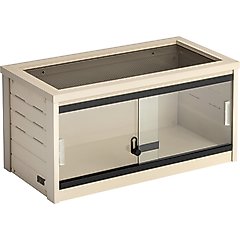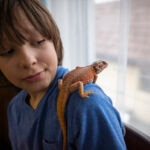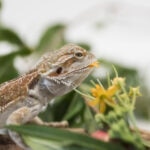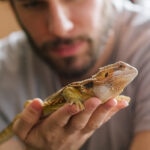Why Do Bearded Dragons Bob Their Heads? Is This Normal?
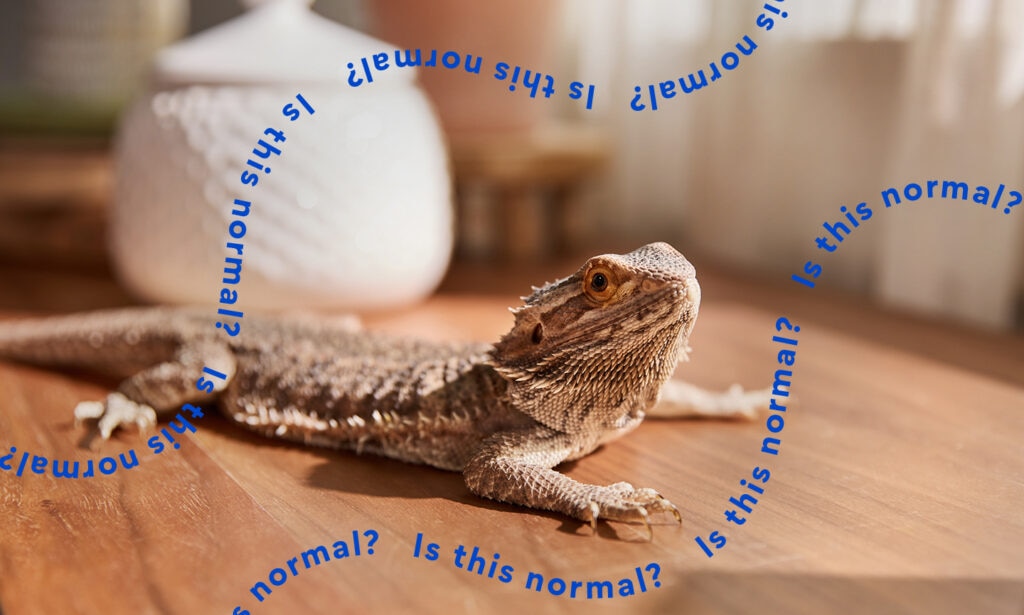
Photo by Chewy
Q: I’ve noticed that my bearded dragon bobs his head whenever he sees his reflection in his tank. It’s almost like he’s bobbing his head to music! Why do bearded dragons bob their heads? Is this normal?
A: Yes! Head bobbing is a normal, common behavior in bearded dragons. Generally, it means a bearded dragon is expressing excitement, asserting dominance, or attracting a mate.
We talked with experts to learn more about this natural bearded dragon behavior.
Key Takeaways
- Head bobbing is normal for bearded dragons: It’s their way of communicating, whether they’re feeling excited, showing dominance, or trying to impress a mate.
- Sometimes it signals stress. If your beardie won’t stop bobbing at a reflection or another dragon, it might be time to tweak their setup.
- Not all head movements are OK. Tremors, tilts, or other odd motions could mean something’s off. Check in with your veterinarian to be safe.
Why Do Bearded Dragons Bob Their Heads?
@scalyadventures It’s a Beardie bobbing battle! 😂 Male Bearded Dragons are very territorial and will bob their heads up and down at each other and their beards turn really dark as a way to show dominance. It’s a serious thing for them for super cute to watch! 🦎 #scalyadventures #beardeddragon #beardeddragons #beardies #reptiles #lizards #scalyfriends ♬ original sound – Scaly Adventures
“One should consider head bobbing in beardies to be like tail wagging in dogs—it’s a form of communication that can mean a lot of different things,” says Krista A. Keller, DVM, DACZM, board certified specialist in zoological medicine and associate professor of clinical zoological companion animal medicine and surgery in the department of medicine and epidemiology at University of California – Davis School of Veterinary Medicine in Davis, California.
Here are some of the most common reasons why bearded dragons bob their heads.
They’re Establishing Dominance
Most commonly, head bobbing in bearded dragons is a behavior used to ward off rival males from intruding on a male’s territory, says Walter Merker, DVM, exotic animal veterinarian at Orange Grove Animal Hospital in Tucson, Arizona. This behavior is their way of telling them, “This terrarium ain’t big enough for the two of us.”
Because it can be too stimulating for them to see other bearded dragons, they may spend most of their day head bobbing away or trying to attack the other bearded dragon, sometimes causing injury to themselves against the front of their enclosure, Dr. Keller says.
Head bobbing can also be a response to other threats, such as birds and other predators—and might even include you when you enter their living space.
They’re Trying To Mate
Head bobbing may occur during periods of excitement in bearded dragons, Dr. Keller says. And while the reasons for excitement can vary, one of them is sexual excitement.
You may notice this behavior more frequently in the spring breeding season when males are trying to impress females, Dr. Merker says.
The females will head bob as well, usually in response to males. When introduced, they may bob their heads to show submission.
They’re Anticipating Something
Why do bearded dragons nod their head, you might wonder? One possible reason is anticipation. Your beardie buddy might be so thrilled that you brought them treats (Fluker’s 5 Star Medley Freeze-Dried Treats, for example) that they’ll bob their head.
Recommended Product
They’re Stressed
Sometimes, head bobbing can indicate that a bearded dragon is feeling stressed.
This behavior may occur more frequently if, for instance, a male has a clear line of vision toward another male or when two are accidentally housed in the same enclosure, Dr. Merker says.
Even if another male beardie is not nearby, the perception that there is can cause a bearded dragon to feel stressed and head bob.
Mirrors or mirror effects from certain types of glass, allowing a bearded dragon to see themselves, can sometimes be the problem, Dr. Keller says.
They May Be Ill
“In states of disease, bearded dragons may move their heads abnormally,” Dr. Keller says. “While these movements are quite distinct from normal head bobbing, they may be mistaken for head bobbing; an experienced beardie lover will be able to tell the difference.”
Some abnormal head movements in bearded dragons include:
- Head tremors, which may happen in states of hypocalcemia (low calcium)
- Head tilt and/or turn, which may indicate there has been trauma, pain, or a mass
- Head nystagmus, which occasionally happens and indicates a condition affecting the vestibular system (which controls balance)
If you notice any of these signs in your bearded dragon, it’s best to consult a vet as soon as possible.
To find a vet near you who’s comfortable working with reptiles, Dr. Keller recommends the Find a Vet tool on the Association of Reptile and Amphibian Veterinarians website.
Should I Worry About My Bearded Dragon’s Head Bobbing?
Typically, you don’t need to worry about head bobbing.
“It’s a big part of the way that they communicate and should not in itself be seen as abnormal behavior,” Dr. Keller says.
However, there are times when it may require some minor changes to their environment.
Because head bobbing can sometimes be a sign of a stressed beardie, it’s important to make sure that male bearded dragons aren’t housed together or in the direct line of vision of another. This can lead to stress or potentially result in injuries from fighting, Dr. Merker says.
In these cases, visual barriers may become necessary, especially if they’re housed in glass enclosures, he adds. Solid-walled enclosures—like the Repti Zoo PVC Terrarium or the New Age Pet Ecoflex Mojave Reptile Habitat—can help limit stress and make bearded dragons feel more secure.
Recommended Products
“Watch closely when your beardie is head bobbing,” Dr. Keller says. “Is it when you have the television on? Is it when they can see another bearded dragon across the way?”
If so, Dr. Keller says to identify a few common triggers—and remove the line of sight and/or audio to these triggers. Then, assess if the head bobbing persists.
If you notice your beardie making unusual head movements beyond normal head bobbing, reach out to your veterinarian.


